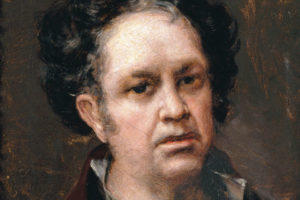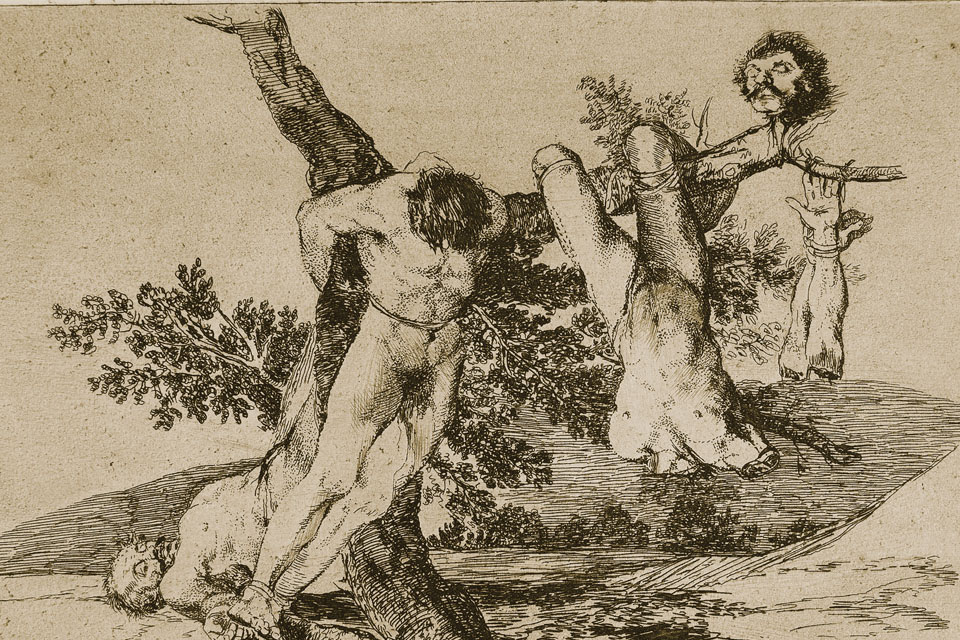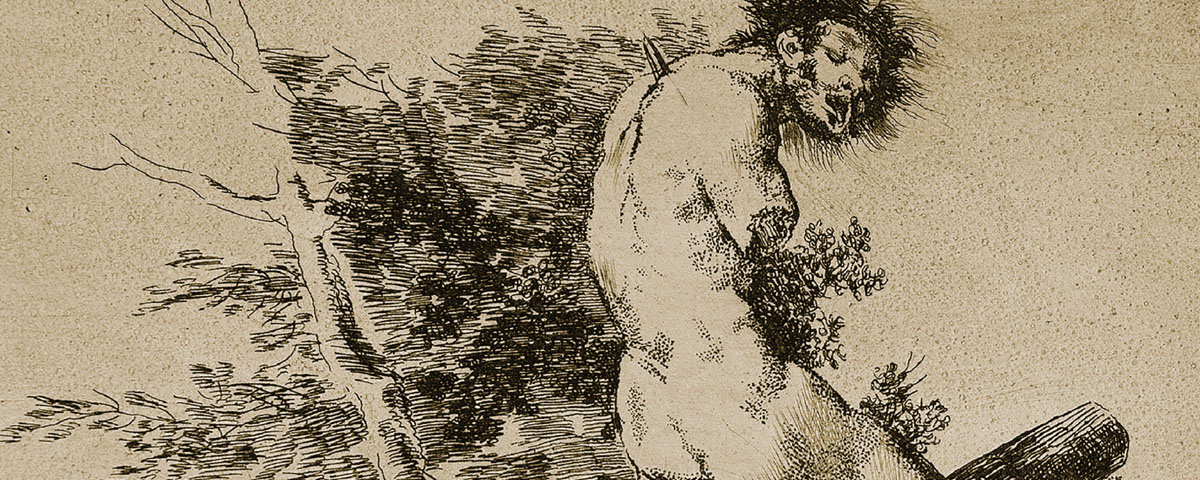Published 35 years after his death, Goya’s The Disasters of War has etched the cruel suffering of war into our collective memory.
WHEN FRENCH EMPEROR NAPOLEON BONAPARTE’S TROOPS invaded Spain in December 1807, Francisco José de Goya y Lucientes (1746–1828) had been First Court Painter to King Carlos IV for more than three decades. Goya was famous not only for his portraits of the Spanish aristocracy but also for his satirical etchings.

During six years of French occupation and guerrilla warfare by Spanish patriots, Goya continued his public career as a court artist, accepting commissions to paint portraits of French generals and other officials connected with the new Bonapartist regime. In private, he created a very different type of work: 85 etchings that depicted the cruelty of war. He titled the series Fatal Consequences of Spain’s Bloody War With Bonaparte. We know it as The Disasters of War.
The French invaded at a time when the Spanish government was in crisis. Long-simmering tensions between King Carlos and his son Ferdinand had come to a head in 1807. Fearing that his father intended to remove him from the succession, Ferdinand negotiated with Napoleon for help in deposing his father.
A popular uprising in March 1808 forced Carlos to abdicate in favor of his son. The new king arrived in Madrid on March 24, the day after the French commander Joachim Murat had entered the city at the head of the French army. Popular resentment against Carlos’s corrupt government was so strong that many Spaniards greeted Murat and the French troops as liberators.
In short order, however, the Spanish people realized that France had come to conquer, not to liberate. Held captive in the French city of Bayonne, both Carlos and Ferdinand were forced to give the reins of power to Napoleon, who proclaimed his brother Joseph king of Spain.
On May 2 violent demonstrations erupted in Madrid as a result of rumors that the French planned to forcibly remove the remaining members of the royal family to Bayonne. A Mamluk cavalry unit that Napoleon had brought back from Egypt charged into the protesters, who were armed with little more than cudgels and knives. Once the riot was subdued, Murat’s men rounded up everyone they could find who was armed and executed them. There were so many of them that the executions lasted through the night and well into the following morning.
The brutal repression of the May 2 protest did not end Spanish resistance. For six years Spanish patriots waged guerrilla warfare against the French occupiers, providing critical support to the British Army in the Peninsular War against France.
Aside from the fact that Goya lived in Madrid during France’s initial invasion and may well have witnessed the May 2 uprising, not much is known about his direct wartime experiences.
We know from his letters that Goya visited his childhood home of Zaragoza after the first siege of the city. Don José de Palafox y Melzi, the Spanish general who led the defense against the attackers, summoned Goya “to see and examine the ruins of the city so as to paint the heroic deeds of its inhabitants.” He arrived in late October and left shortly before the French began their second, more successful assault on the city in December. By May 1809 at the latest, Goya was back in Madrid, where he would spend the rest of the war and witness the famine it wrought on Madrid in 1811 and 1812—a famine so devastating that 20,000 of its residents died of starvation.
Goya began etching the plates that make up The Disasters of War in 1810, and he appears to have worked on them through the end of the war. When his supplies ran low, he cut in two the copperplates for two landscapes he had etched before the war and created his scenes of war on the reverse sides.

The series can be divided into three rough parts. The first part deals with scenes of war. The second depicts the sufferings of famine. The third—comprising 16 etchings—consists of biting political satires aimed at those who benefited under the French occupation.
Goya used a wide range of etching techniques. Drawing on figures and compositions from classical antiquity and Renaissance masters, he created images that combine beauty with horror. In what appear to be earlier plates (based on stylistic similarities to the few plates dated 1810), Goya created delicate effects of line and wash—techniques that contrast with the gruesome scenes they portray. These plates display complex scenes in which many small figures are crowded into compositions that often subvert the heroic conventions of traditional battle scenes. Other plates, generally considered to date from later in the war, are less finished in style, with larger-scale figures set against simplified backgrounds that bring greater clarity to the horrors they depict.
Both sides in the war were merciless, and Goya is impartial in his depiction of their cruelties. He treats the atrocities that French soldiers suffered at the hands of his countrymen and those that French soldiers inflicted on ordinary Spanish citizens with the same sense of pity and condemnation; there is no difference between combatants and noncombatants. Men are shot, hanged, tortured, and dismembered. Women fight to defend themselves, sometimes with children in their arms. The wounded are pressed into service despite their pain. Children weep for dead mothers. Even the dead receive no respect: Soldiers strip corpses before throwing them into a common grave.
Some plates bear titles such as Yo lo vi (I saw it) and Así sucedió (This is how it happened) that suggest Goya saw at least some of the events he depicts. But while many of the plates offer the immediacy of an eyewitness account, others, such as Esto es peor (This is worse), combine fantastical atrocities with painstaking realism.
Only one plate, titled Que valor! (What courage!), refers to an identifiable event. It is the only heroic image in the series. In it, a young woman, seen from behind, climbs over the bodies of her fallen countrymen and fires a cannon at an unseen foe—a clear reference to the actions of Augustine Domènech, who stepped into a defensive breach and fired a cannon during the first siege of Zaragoza.
After the war King Ferdinand VII returned to his throne, and Goya regained his title and salary as first court painter, thanks to friends who testified that he had not supported Joseph Bonaparte’s brief rule. He kept his head down, creating portraits of the court and a series of etchings depicting the history of bullfighting in Spain. Meanwhile, he prepared his wartime etchings for future publication. In 1819 he gave fellow artist and writer Juan Agustín Ceán Bermúdez his original etchings and a full set of working proofs, with each sheet numbered and captioned—presumably intending to publish the plates as a series.
But Goya’s The Disasters of War remained unpublished until 1863—a half century after its creation and a year after Mathew Brady displayed his photographs of the bloody battlefield at Antietam on the door of his New York photography studio. In the years since their publication, Goya’s prints have been acclaimed for what photographer Susan Sontag described in Regarding the Pain of Others as “a new standard for responsiveness for suffering.” After the First World War, German Expressionist artist Otto Dix modeled his own print series Der Krieg on Goya’s work. Photojournalists assigned to cover modern wars have pointed to Goya’s war etchings as precursors of their reportage from the battlefront.
As immediate as a snapshot and as artificial as many of the earliest examples of war photography, The Disasters of War demands that the viewer share Goya’s horror. In Goya’s hands, war is anything but glorious and heroes are in short supply. MHQ
PAMELA D. TOLER writes frequently about history and the arts. She is the author of Heroines of Mercy Street: The Real Nurses of the Civil War (Little, Brown and Company, 2016) and is currently working on a global history of women warriors.
[hr]
This article appears in the Autumn 2017 issue (Vol. 30, No. 1) of MHQ—The Quarterly Journal of Military History with the headline: Eyewitness to Horror

Want to have the lavishly illustrated, premium-quality print edition of MHQ delivered directly to you four times a year? Subscribe now at special savings!






